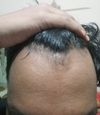community Fin- 4.5 months, Min-2.5 months, still long way to go
The user has been treating hair loss with 1mg oral finasteride daily, 1mg topical minoxidil twice daily, and microneedling twice a week. They report improved hair quality and density but are still experiencing shedding.
